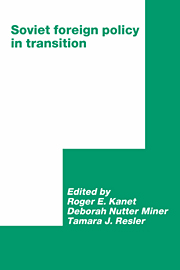Book contents
- Frontmatter
- Contents
- List of tables
- List of contributors
- Preface
- Introduction
- Part I The Soviet Union and the international political system
- Part II The Soviet Union and Europe
- Part III The Soviet Union and the developing world: global trends
- Part IV The Soviet Union and the developing world: regional and country case studies
- 8 Soviet policy in Central America during the Gorbachev period
- 9 The Soviet reassessment of socialist orientation and the African response
- 10 Soviet policy in the Middle East: Gorbachev's imprint
- 11 The implications of perestroika for the Third World, particularly Asia
- 12 The Soviet Union and Indochina
- 13 Gorbachev's Southeast Asia policy: new thinking for a new era?
- 14 The impact of Gorbachev's new thinking on Soviet policy toward South Korea
- Part V Conclusion
- Index
10 - Soviet policy in the Middle East: Gorbachev's imprint
Published online by Cambridge University Press: 05 February 2012
- Frontmatter
- Contents
- List of tables
- List of contributors
- Preface
- Introduction
- Part I The Soviet Union and the international political system
- Part II The Soviet Union and Europe
- Part III The Soviet Union and the developing world: global trends
- Part IV The Soviet Union and the developing world: regional and country case studies
- 8 Soviet policy in Central America during the Gorbachev period
- 9 The Soviet reassessment of socialist orientation and the African response
- 10 Soviet policy in the Middle East: Gorbachev's imprint
- 11 The implications of perestroika for the Third World, particularly Asia
- 12 The Soviet Union and Indochina
- 13 Gorbachev's Southeast Asia policy: new thinking for a new era?
- 14 The impact of Gorbachev's new thinking on Soviet policy toward South Korea
- Part V Conclusion
- Index
Summary
When Mikhail S. Gorbachev became General Secretary of the Communist Party of the Soviet Union in March 1985, the USSR was enmeshed deeply in Afghanistan, the Arab–Israeli dispute appeared both treacherous and stalemated, and the then five-year-old Gulf War presented increasingly serious problems to the Soviet Union. In 1985, the Soviet leadership was unwilling to consider withdrawing from Afghanistan, despite the war's rising costs. In the Arab–Israeli arena, the business-as-usual rhythm of siding with the Arabs against US-backed Israel was broken by the Camp David Accords and the Egyptian–Israeli peace treaty. Although Arab enmity toward Egypt provided Moscow with the initially strong rallying point of “rejectionism,” in the long run this position left the Soviets with client states that were more or less peripheral to the central Middle East concerns. In the Gulf region, the Iran–Iraq War forced Moscow to play a careful balancing act between its military/political links with Baghdad and its hoped-for ties with anti-American Iran. Moreover, the war's divisive effects on the Middle East scuttled Soviet attempts at rallying Arab forces against the United States and Israel.
These events, in a nutshell, formed the Brezhnev (and Andropov and Chernenko) legacy to Mikhail Gorbachev. In contrast, the past five years have shown clearly that Gorbachev's priority, unlike that of his predecessors, is domestic reconstruction. This look inward required a different kind of foreign policy, one conducive to perestroika at home.
- Type
- Chapter
- Information
- Soviet Foreign Policy in Transition , pp. 196 - 216Publisher: Cambridge University PressPrint publication year: 1992



